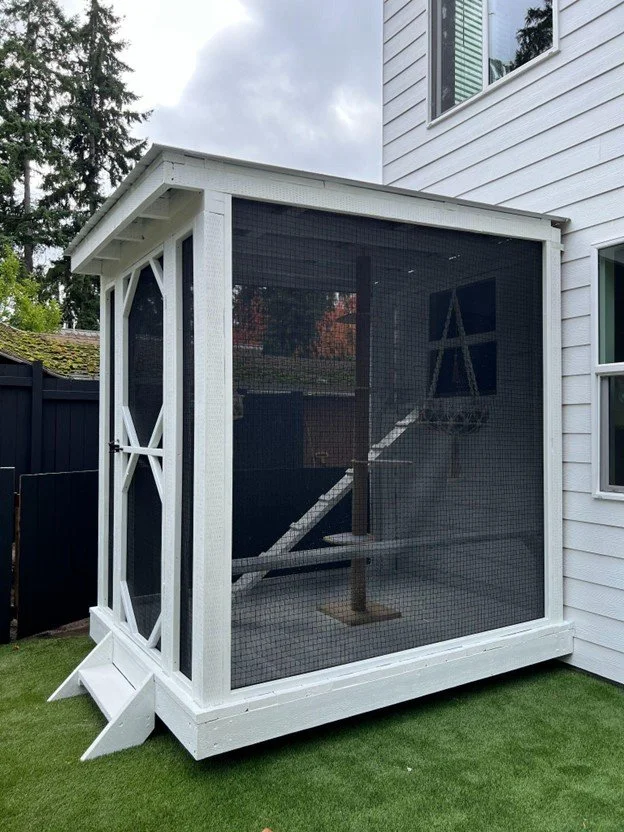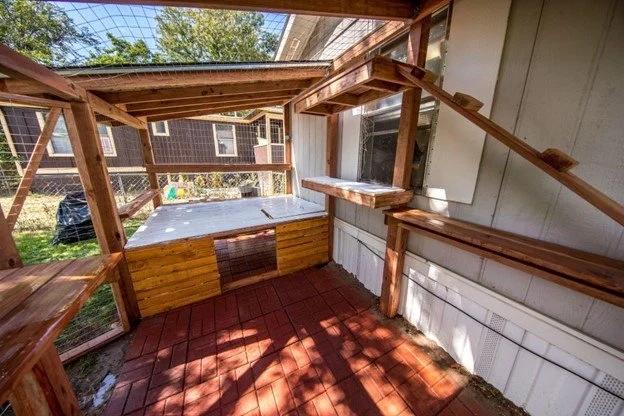Catios as Outdoor Enrichment for Indoor Cats
By Alex Harding
In the world of feline care, the debate between indoor and outdoor lifestyles for cats presents a complex array of concerns and benefits. With growing urbanization and the increased risks outdoors—from traffic to predators and diseases—the push towards keeping cats indoors has gained momentum. However, this shift brings with it the responsibility to create indoor environments that cater not just to the basic needs of cats but to their inherent behavioral instincts and well-being.
Understanding the Indoor Cat: Insights from Research
The significance of an enriched indoor environment cannot be overstated. Studies, such as those by Anna Scandurra and colleagues, have brought to light the nuanced needs of domestic cats, emphasizing how different living environments affect their behavior and stress levels. For instance, Scandurra's team observed cats in home environments engaging in problem-solving tasks, noting that indoor cats displayed greater perseverance, indicating the importance of cognitive stimulation.
The principles derived from their findings strongly support the idea that enriched indoor spaces can significantly enhance the quality of life for indoor cats. One such option for an enriched indoor space is a ‘catio’ or cat enclosure that extends outside but keeps the cat within an enclosed environment. These specially designed enclosures offer cats the stimulation of the outdoors while keeping them safe from external threats. This blending of indoor safety with an enclosed environment that extends outdoors plays a crucial role in responsible cat care today.
Photo of a cat in an enclosed catio space. Photo courtesy of Cat Topia.
The Role of Catio’s in Feline Well-Being
Catios, or cat enclosures, provide a sanctuary where cats can indulge their curiosity and natural behaviors in a controlled environment. Here are several ways catios contribute to a cat's quality of life:
Mental Stimulation: Access to an outdoor, enclosed space, offers cats a change of scenery and the opportunity to observe the world, keeping their minds active and engaged.
Physical Exercise: Features within catios, such as climbing towers, bridges, and scratching posts, encourage physical activity, helping to maintain a healthy weight and reduce the risk of obesity-related diseases.
Stress Reduction: Providing a safe space with some outdoor stimulation that is contained which significantly reduces stress levels, especially in multi-pet households where social tension may exist.
Behavioral Health: Catios allow cats to express natural behaviors such as scratching, climbing, and exploring in appropriate ways, potentially reducing unwanted behaviors inside the home.
Implementing the Five Basic Systems for Indoor Cats
Research by Herron and colleagues emphasizes the importance of structuring the indoor environment into five basic systems—physical resource, nutritional, elimination, social, and behavioral—to ensure it meets the behavioral and welfare needs of cats. By understanding and addressing these systems, cat owners can prevent behavior problems and enhance their pets' quality of life.
Physical Resource System: Ensures stability and comfort with resting areas, perches, and safe havens, minimizing stress.
Nutritional System: Mimics natural hunting with puzzle feeders and varied feeding stations, encouraging healthy eating habits.
Elimination System: Offers accessible litter boxes in quiet, secure areas, promoting stress-free elimination.
Social System: Allows cats control over social interactions, reducing conflicts in multi-pet households.
Behavioral System: Provides toys, scratching posts, and safe plants for natural behaviors, supporting mental and physical health.
A double-screened catio. Photo courtesy of Cat Topia.
Enclosed Spaces and Sensory Stimulation
An enriched enclosed space such as a catio can provide cats with the opportunity to experience changes in weather, observe wildlife, and interact with the natural world around them. This direct engagement with the outdoors significantly contributes to both their mental and physical health. According to research, enriched environments should offer both visual and olfactory enrichment.
Visual Enrichment: Offering access to windows or video playback featuring prey or other cats can keep indoor cats mentally stimulated. However, the inability to physically interact with these sights might lead to frustration, indicating a need for further welfare impact research in the field.
Olfactory Enrichment: Introducing scents has been shown to elicit positive behavioral responses such as sniffing, pawing, and playing. This suggests that familiar and enjoyable scents significantly improve the quality of life for confined cats.
By thoughtfully combining the physical security provided by catios with the engaging aspects of sensory enrichment, cat owners can create a living environment that fully addresses the needs of their indoor cats. This holistic approach not only caters to their physical safety but also ensures their mental and emotional health, leading to a more fulfilled and enriched life for our feline companions.
A catio with a dedicated space for a space for a litter box in a safe and secure area. Photo courtesy of Cat Topia.
The transition to keeping cats indoors, while beneficial for their safety and health, brings with it the responsibility to ensure their environment is as enriching and stimulating as possible. Catios are an innovative solution, bridging the gap between the need for safety and the instinctual desires of our feline companions.
The shift towards promoting indoor living for cats presents an opportunity to safeguard both cats and the wildlife we strive to protect. By integrating behavioral research insights into our approach and adopting solutions like catios, we can create enriching indoor environments for cats that also contribute to the conservation of bird species and other wildlife. This balanced approach ensures that we fulfill our responsibilities as pet owners and conservationists, promoting harmony between domestic animals and the natural world.
Sources
Ellis, SLH. Environmental Enrichment: Practical Strategies for Improving Feline Welfare. Journal of Feline Medicine and Surgery. 2009, 11(11):901-912. 10.1016/j.jfms.2009.09.011
Herron, ME, and CA Buffington. Environmental enrichment for indoor cats. Compend. Contin. Educ. Vet. 2010, 32(12):E4 (Download PDF of Full Article).
Scandurra, A. et al. Home Sweet Home: The Impact of Lifestyle on a Cat's Approach to Impossible Tasks in the Home Environment. Animals. 2023, 13:2679. 10.3390/ani13162679.



